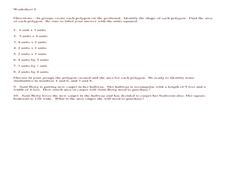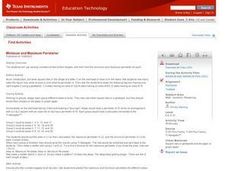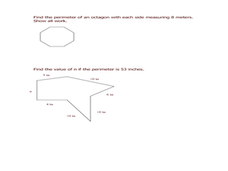Bowland
Geoboard Squares
Don't be a square! Help your budding mathematicians discover patterns within squares. Scholars create squares on geoboards and identify patterns in the number of nails, both nails on the edge of the squares and nails within the squares....
Utah Education Network (UEN)
Geo Shapes
Invite your first graders to compose and decompose two and three-dimensional figures with this fun, hands-on instructional activity. They investigate and predict the results of putting together and taking apart two-dimensional shapes...
Curated OER
The Greedy Triangle-Intro to Geometric Shapes
In this geometry lesson plan, learners read The Greedy Triangle and use geoboards to construct geometric shapes. They identify the number of sides and angles each shape has.
Curated OER
Geoboard Activity
In this geometry worksheet, 10th graders use geoboards or the grid representation of a geoboard to construct the indicated geometric figure. The three page worksheet contains twenty-seven questions. Answers are not included.
Illinois State Board of Education
Geoboard Areas
Middle school geometers determine the area of a shape on a geoboard or dot paper and draw figures that meet given area conditions. Working as a class, they develop and discuss various ways to draw geometric shapes with specified...
Curated OER
How Many Units?
Young mathematicians calculate the area of rectangles and squares. For this geometry lesson, learners are grouped in pairs and use geoboards to construct rectangles. They calculate the area of the figure by counting the number of square...
Curated OER
Learning by Logic - Total Surface Area
Geometers calculate the area of plane surfaces using the formulas for the area of a square, rectangle, and triangle. They develop the formula for calculating the total surface area of two geometric solids: the cube and rectangular prism.
Curated OER
Shape Up!
An outstanding lesson on teaching the basic shapes and polygon names to young geometers is here for you. In it, learners investigate the role of basic polygons in the strength of structures. They use geoboards, rubber bands, streamed...
National Security Agency
Classifying Triangles
Building on young mathematicians' prior knowledge of three-sided shapes, this lesson series explores the defining characteristics of different types of triangles. Starting with a shared reading of the children's book The Greedy Triangle,...
Curated OER
Ship Shape
Third graders experiment with, identify, and follow teacher-directed instruction toward understanding two-dimensional geometric shapes found within the environment. Groups of students utilize geoboards to help them explain geometric shapes.
Curated OER
Get in Shape with Geometry
Using geoboards, computer programs, and hands-on manipulative materials, elementary schoolers engage in a study of two and three-dimensional geometric shapes. This instructional activity is chock full of good teaching ideas on the...
Alabama Learning Exchange
Abundant Area
Explore the relationship between perimeter and area. Learners input the area and perimeter for shapes on the Shape Explorer website, solve problems using geoboards, complete a worksheet, create a PowerPoint presentation, and take an...
Curated OER
Cut - Stretch - Fold
Students work on determining the area of a tangram piece without using a formula by working with geoboards, graph paper, and tangram pieces. After completing the activity, they apply their experience to determining a formula for finding...
Illustrative Mathematics
Same Base and Height, Variation 1
Four triangles are depicted for learners to construct on a geoboard. They compute and compare the areas, and so meet one of the sixth grade Common Core standards for geometry. Note that the set of triangles does not include a right...
National Security Agency
Awesome Area - Geometry and Measurement
Break out those math manipulatives, it's time to teach about area! Capturing the engagement of young mathematicians, this three-lesson series supports children with learning how to measure the area of squares, rectangles, and other...
Curated OER
Area of a Parallelogram
Fifth graders will use geoboards to construct parallelograms. They will determine the area of a rectangle and then apply that thinking to determine the area of a parallelogram. Note: The format of this lesson is much like a PowerPoint,...
Curated OER
Powerful Polygons
Students scan the classroom to find different common shapes. They listen as the teacher defines polygon and regular polygon. The teacher demonstrates regular polygons via the Internet and the "Math is Fun" web site. Students go outside...
Curated OER
Minimum and Maximum Perimeter
Pupils practice a variety of strategies with varying numbers of tiles to form shapes and then find the minimum and maximum perimeter for each one. Each group is assigned a different area to build either with square tiles or a geoboard....
Curated OER
Using R&R to Teach Mathematics
Second graders create a shape garden. In this polygons lesson, 2nd graders practice making shapes using a geoboard and read the book The Greedy Triangle by Marilyn Burns. Students also design a shape garden using construction paper.
Curated OER
Quadrilateral Attributes
Students classify quadrilaterals. In this quadrilateral lesson plan, students identify the characteristics of quadrilaterals. They write their findings in a journal. Students use geoboards to create quadrilaterals from given descriptions.
Curated OER
Shapes Galore!
First graders explore two-dimensional shapes. Individually, children follow directions to draw shapes. Learners use shaving cream, geoboards, yarn, marshmallows, and toothpicks to create shapes. As a class, 1st graders brainstorm...
Curated OER
Count Them Up
Pupils calculate area using the geoboard application on their calculators. They use a TI-73 calculator to find the areas of the shapes provided in the accompanying worksheet. Screen shots and instructions for creating shapes in the...
Curated OER
Algebra/Geometry Institute Summer 2007 - Perimeter of Polygons
Sixth graders find the perimeters of polygons and use perimeters to form polygons. In this perimeter lesson, 6th graders study vocabulary associated with finding perimeter such as polygon, line segment, variable, and formula. They make...
Curated OER
Lines and Angles
Sixth graders explore lines and angles. They create visual representations of lines, rays and angles by drawing them on paper and using a geoboard. On paper, 6th graders write a summary of the characteristics of their representations.
Other popular searches
- Math Lessons Geoboards
- Geoboards Array
- Using Geoboards
- Geometry Using Geoboards
- Electronic Geoboards
- Geoboards Shapes
- Geoboards Fractions
- Geometry Geoboards
- Shapes With Geoboards
- Geoboards Perimeter
- Geoboards Area
- Greedy Triangle Geoboards

























